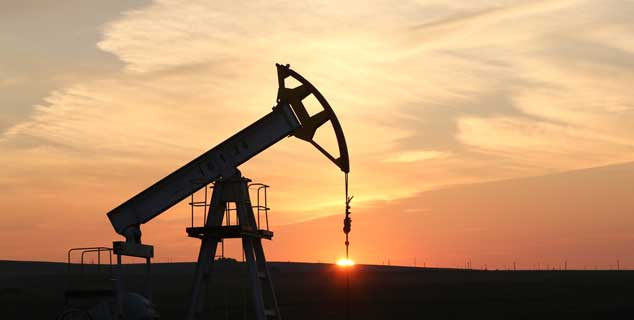
A supply glut and a slowdown in global demand has weighed heavily on the oil price. And that won’t change any time soon, says Simon Wilson.
What’s happened?
Oil prices have seen a volatile week or so, with benchmark measures for the price of a barrel of crude (Brent and West Texas Intermediate – WTI) seeing record spasms both higher and lower in recent sessions. However, the big picture is that the price of oil remains around half of what it was a year ago, around the $50 a barrel range for Brent and $45 for WTI.
Between the spring of 2011 and the summer of 2014, prices were unusually steady, mostly trading within about ten dollars of the $110 mark, a level that came to be seen as the new normal. But in the year since then, the price of Brent collapsed to below $50 in January, and perked up a bit in the spring to above $65 – before resuming its downward trend and hitting a six-year low of $43 in August.
Why has the price slumped?
Obviously, oil is a commodity and its price is sensitive to shifts in supply and demand. Right now there is a glut in the supply of oil, while demand has slowed. US domestic production has doubled in the past six years (thanks largely to the shale boom), pushing out imports. That means oil from (for example) Saudi Arabia, Nigeria and Algeria, formerly sold to the US, is now competing for other markets, such as Asia, driving prices down. Other key producers, such as Canada and Iraq, have also lifted production.
Meanwhile, global demand has been hit by weak activity – especially in Europe and some developing countries – but also by the increased efficiency of many vehicles, and a shift away from oil to other fuels and renewables. The six-year lows late last month coincided with fears that China’s stockmarket turbulence and slowing growth will spill over into a global slowdown, especially in demand for all commodities, not just oil. Meanwhile, investors have also been betting on further price falls.
How long will the price stay low?
The consensus view is that it will be years, not months. According to an Opec memo leaked to The Wall Street Journal earlier this year, the oil-producing nations’ club believes the price will not return to $100 for at least a decade. Indeed, in its most optimistic scenario, oil will be trading at around $76 in 2025.
Pierre Andurand, a hedge-fund manager (and oil-price bear) who predicted the 2008 oil spike and subsequent crash, reckons “the market will remain oversupplied in 2016 and 2017” and thinks prices will remain low, possibly dropping below $30 a barrel.
Nick Butler, a former BP vice-president who is now an energy academic writing for the FT, takes a similar view – arguing that on current fundamentals “the cycle will take at least five years to turn and quite possibly longer”.
What’s his reasoning?
Currently, the excess of production over consumption was as much as three million barrels a day (in the second quarter of 2015) – explaining the low prices. On the supply side, Butler reckons production will grow for at least the next two years, led by growth from Iran, while demand will be flat, held back by the Chinese slowdown. Thus supply will outstrip demand for at least two years. Even once they are back in balance, “the market will have to cope with the volume of stocks that are being built up”.
Today’s low price means many new exploration and drilling projects are being postponed or mothballed. But the cycle will only turn when the postponement of projects starts to affect total supplies (ie, including the build-up of surplus stocks). Given all that, Butler reckons (barring politically-motivated intervention, by the Saudis, say) there won’t be a cyclical turn towards higher prices for “at least five years”.
Opec has traditionally cut supply to prop up the oil price. But this time around its dominant player, Saudi Arabia, has taken a strategic decision to fight for market share, rather than provide a higher oil price that makes life easier for rivals – in particular, more expensive US fracking. They might yet change tack, under pressure from other Opec members (and in the interests of political self-preservation), but there’s no sign of that so far.
What does all this mean for oil firms?
Less than two years ago most big oil companies viewed a price of $100 as a downside risk to be factored into their planning. Now a price of half that looks like it could be the new normal for the foreseeable future. How will they respond? Cutting production is unlikely, argues Butler: once projects are running, most of the money has already been spent. Inevitably, some new projects will be delayed and cost-cutting programmes intensified.
Investors can also expect far lower dividends, or none at all, in the next few years – as well as rising merger activity, as firms with strong balance sheets look to snap up those who need oil at $100 a barrel to turn a profit.
Can the Granite City weather the storm?
When the oil price collapsed in the late 1990s, Aberdeen collapsed with it, says The Economist. Thousands of foreign oil workers left and the local economy went into a mini-depression. This time round, the city’s hotels and restaurants are already much quieter than they were, and unemployment has risen (at a time when employment in the rest of Scotland is still rising).
Property prices are still rising on an annualised basis, but according to the Press and Journal, higher-end sales are “subdued”, while anecdotal evidence suggests “demand for office and commercial space” is falling.
As Andrew Laing of Aberdeen Asset Management told Management Today in February: “The immediate effect isn’t too bad, but within three months, six months, nine months, it begins to knock on.”